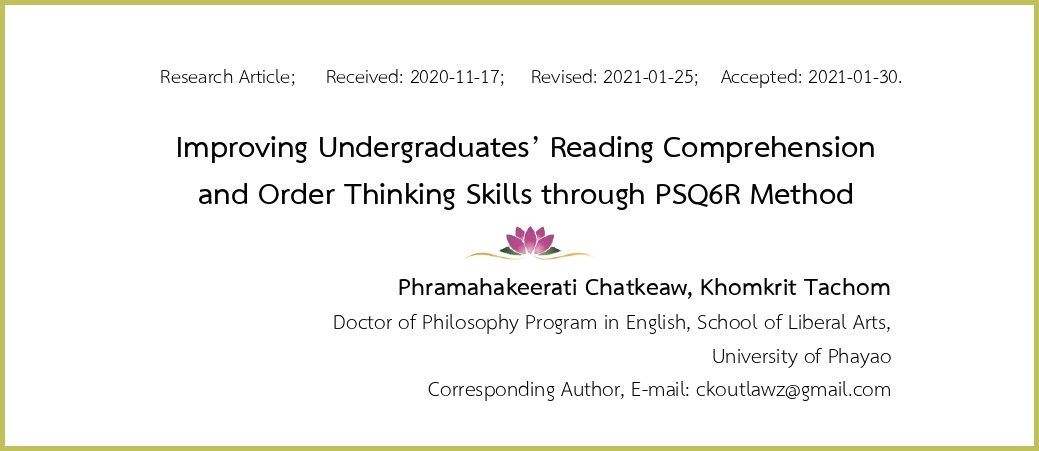Improving Undergraduates’ Reading Comprehension and Order Thinking Skills through PSQ6R Method
Keywords:
Development, Reading Comprehension, Teaching Reading, PSQ6R Method, Order ThinkingAbstract
The purpose of this research is to 1) compare the undergraduates’ reading comprehension ability; and 2) study the students’ order thinking skills related to reading comprehension ability, before and after learning by using PSQ6R method. The chosen sample size includes 47 undergraduates enrolled in the English Dhamma course at Nakhon Lampang Buddhist College in the 1st semester of academic year 2020. The samples are derived from the purposive selection method. The research instruments are English reading comprehension learning package adopting PSQ6R method and reading comprehension tests. The data are analyzed with percentage, mean, standard deviation, and t-test.
The research findings demonstrate that the undergraduates’ reading comprehension ability and order thinking skills after learning through PSQ6R method is significantly higher than that of before, which is at .05 level of significance. Hence, the PSQ6R method can be used as an essential tool in developing the reading comprehension and thinking skills of a broad range of knowledge-based learners. The new body of knowledge indicates that the PSQ6R method seems to be suitable for enhancing reading comprehension and order thinking skills for students with diverse background knowledge of English at Buddhist Colleges. The students in this context need more teacher’s attention to scaffold them to read English texts or passages concerning Dhamma comprehensibly and successfully by using the PSQ6R method. The Bloom taxonomy can be used to gauge the students’ order thinking skills and assist students to read English texts critically.
References
Alyousef, H. S. (2005). Teaching Reading Comprehension to ESL/EFL Learners. The Reading Matrix. 5 (2), 143-154.
Athipati, C. (2014). Reading Comprehension Development: The Use of SQ5R Technique for Matthayomsuksa 3 Students. (Master’s Thesis). Mahasarakham University. Mahasarakham.
Basar, M. and Gürbüz, M. (2017). Effect of the SQ4R Technique on the Reading Comprehension of Elementary School 4th Grade Elementary School Students. International Journal of Instruction. 10 (2), 131–144.
Calderon, M. E., et al. (1992). Adapting Cooperative Intergrated Reading and Composition to Meet the Needs of Bilingual Students. The Journal of Educational Issues of Language Minority Students. (10), 79-106.
Hayikaleng, N., et al. (2016). Thai Students’ L2 Reading Comprehension Level for Lower Order Thinking Skills and Higher Order Thinking Skills Questions. Journal of Applied Linguistics and Language Research. 3 (5), 83-91.
Kamali, A. N., et al. (2018). Development of SQ5R Flipped Classroom Model for English Reading on King Bhumibol Sufficiency Economy for Grade 10 Students. Academic Services Journal, Prince of Songkla University. 29 (3), 26-39.
Khummasorn, J., et al. (2016). A Critical Reading Development in Matayomsksa 5 Students Using SQ5R Method via Newspapers. (Master’s Thesis). Mahasarakham University. Mahasarakham.
Mohammadi, A. and Davarbina, M. (2015). The Effect of Cooperative Learning Techniques on Reading Comprehension Ability of Iranian EFL Learners. International J. Soc. Sci. & Education. 5 (3), 525-531.
Nourdad, N., et al. (2018). The Effect of Higher Order Thinking Skill Instruction on EFL Reading Ability. International Journal of Applied Linguistics and English Literature. 7 (3), 231-237.
Nurul, L. K., et al. (2017). Improve English Reading Comprehension Ability through Survey, Question, Read, Record, Recite, Review Strategy (SQ4R). English Language Teaching. 10 (12), 202-211.
Sangcharoon, T. (2010). Reading and Writing Skills Development: The Use of SQ5R Technique. (Doctoral Dissertation). Prince of Songkla University. Songkla.
Sayasen, S. (2018). Effects of Using the SQ5R Methods on Improving Lao EFL College Students' Reading Comprehension. (Master’s Thesis). Buriram Rajabhat University. Buriram.
Supayo, N. (2001). The Implementation of PSQ4R Teaching Methods to Promote Reading Comprehension, Retention, and Comprehension Monitoring Abilities of Mathayom Suksa 5 Students. (Master’s Thesis). Chiang Mai University. Chiang Mai.
Suratsawadee, P. (1996). Activities and English Material for Primary School Level. Bangkok: Chulalongkorn University Press.
Taotayong, A. and Kuha, A. (2011). Effects of Cooperative Learning by Using CIRC Program on Writting and Reading Ability on English Language Achievement of Billingual Students. Princess of Naradhiwas University Journal. 3 (2), 65-80.
Veeravagu, J., et al. (2010). Using Bloom’s Taxonomy to Gauge Students’ Reading Comprehension Performance. Canadian Social Science. 6 (3), 205-212.
Zare, P. and Othaman, M. (2013). The Relationship between Reading Comprehension and Reading Strategy Use among Malaysian ESL Learners. International Journal of Humanities and Social Science. 3 (13), 187-193.
Zarei, A. A. (2012). The Effects of STAD and CIRC on L2 Reading Comprehension and Vocabulary Learning. Frontiers of Language and Teaching. 3, 161-173.






